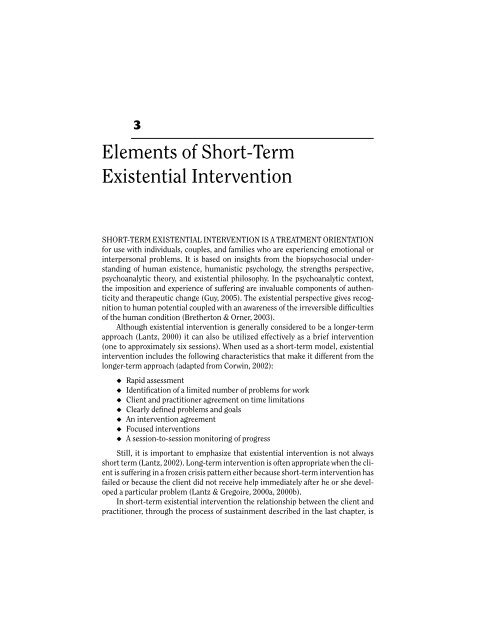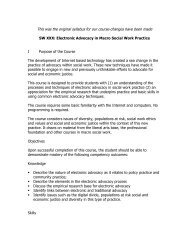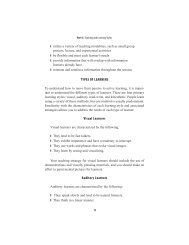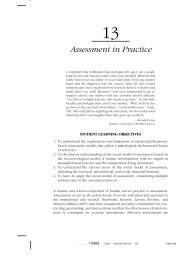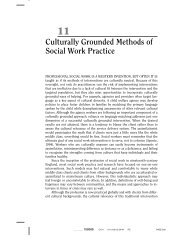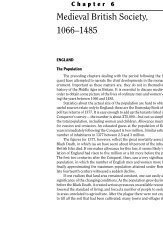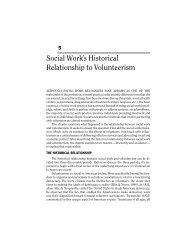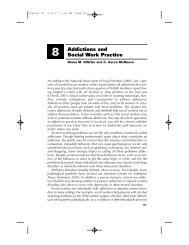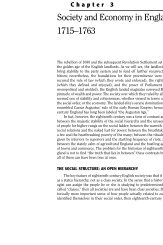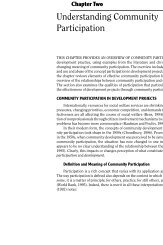Elements of Short-Term Existential Intervention - Lyceum Books
Elements of Short-Term Existential Intervention - Lyceum Books
Elements of Short-Term Existential Intervention - Lyceum Books
Create successful ePaper yourself
Turn your PDF publications into a flip-book with our unique Google optimized e-Paper software.
3<br />
<strong>Elements</strong> <strong>of</strong> <strong>Short</strong>-<strong>Term</strong><br />
<strong>Existential</strong> <strong>Intervention</strong><br />
SHORT-TERM EXISTENTIAL INTERVENTION IS A TREATMENT ORIENTATION<br />
for use with individuals, couples, and families who are experiencing emotional or<br />
interpersonal problems. It is based on insights from the biopsychosocial understanding<br />
<strong>of</strong> human existence, humanistic psychology, the strengths perspective,<br />
psychoanalytic theory, and existential philosophy. In the psychoanalytic context,<br />
the imposition and experience <strong>of</strong> suffering are invaluable components <strong>of</strong> authenticity<br />
and therapeutic change (Guy, 2005). The existential perspective gives recognition<br />
to human potential coupled with an awareness <strong>of</strong> the irreversible difficulties<br />
<strong>of</strong> the human condition (Bretherton & Orner, 2003).<br />
Although existential intervention is generally considered to be a longer-term<br />
approach (Lantz, 2000) it can also be utilized effectively as a brief intervention<br />
(one to approximately six sessions). When used as a short-term model, existential<br />
intervention includes the following characteristics that make it different from the<br />
longer-term approach (adapted from Corwin, 2002):<br />
◆ Rapid assessment<br />
◆ Identification <strong>of</strong> a limited number <strong>of</strong> problems for work<br />
◆ Client and practitioner agreement on time limitations<br />
◆ Clearly defined problems and goals<br />
◆ An intervention agreement<br />
◆ Focused interventions<br />
◆ A session-to-session monitoring <strong>of</strong> progress<br />
Still, it is important to emphasize that existential intervention is not always<br />
short term (Lantz, 2002). Long-term intervention is <strong>of</strong>ten appropriate when the client<br />
is suffering in a frozen crisis pattern either because short-term intervention has<br />
failed or because the client did not receive help immediately after he or she developed<br />
a particular problem (Lantz & Gregoire, 2000a, 2000b).<br />
In short-term existential intervention the relationship between the client and<br />
practitioner, through the process <strong>of</strong> sustainment described in the last chapter, is
Chapter 3 <strong>Elements</strong> <strong>of</strong> <strong>Short</strong>-<strong>Term</strong> <strong>Existential</strong> <strong>Intervention</strong> 23<br />
the most important variable in helping the client overcome or master the problem<br />
situation. It is the practitioner’s responsibility to use the relationship and the intervention<br />
process to help the client enrich his or her life at the three “dimensions<br />
<strong>of</strong> existence” that are <strong>of</strong>ten disrupted by a problem situation. These dimensions<br />
include being “<strong>of</strong>” the world, “in” the world, and “for” the world (Frankl, 1969;<br />
Lantz, 2001).<br />
This chapter outlines the process <strong>of</strong> short-term existential intervention from<br />
the point <strong>of</strong> view <strong>of</strong> these three dimensions <strong>of</strong> existence. <strong>Intervention</strong> cannot be<br />
described as existential unless the practitioner consistently focuses interventions<br />
toward growth at each <strong>of</strong> the three dimensions (Lantz, 2001, 2002).<br />
BEING “OF” THE WORLD<br />
The phrase “being <strong>of</strong> the world” refers to the fact that the human being has a<br />
body and must obey the rules <strong>of</strong> the biological and physical world. Frankl (1969) describes<br />
this dimension as the must dimension <strong>of</strong> existence. At the must dimension<br />
<strong>of</strong> existence, human beings must consume food and water or they will die, must die<br />
<strong>of</strong> hypothermia if they are deprived <strong>of</strong> clothing and shelter in cold weather, and must<br />
experience depression if certain biochemical imbalances exist within the central<br />
nervous system (Lantz, 2001). In short-term existential intervention, it is important<br />
to realize that at times the client is in need <strong>of</strong> medical-oriented services, and<br />
that comprehensive intervention includes the practitioner’s willingness to link the<br />
client to a medical provider when such services are needed. (See “biological coping”,<br />
in chapter 2.) Common problems that originate at the must dimension <strong>of</strong> existence<br />
include cancer, heart disease, emphysema, arthritis, acute lateral sclevosis (ALS),<br />
AIDS, some forms <strong>of</strong> depression, and organic brain diseases.<br />
The central treatment issue at the must dimension <strong>of</strong> existence is physical<br />
vitality (Frankl, 1969; Lantz, 1978).<br />
BEING “IN” THE WORLD<br />
The phrase “being in the world” refers to the fact that people have some freedoms<br />
in their existence and can make many choices in life reactive to difficulties and<br />
opportunities (Berg & Dolan, 2001; Frankl, 1955). Being “in” the world refers to the<br />
fact that all people can have an impact on their inner and outer environments and<br />
are both reactive and proactive living beings. Frankl (1997) describes this dimension<br />
<strong>of</strong> existence as the can dimension. In the can dimension, the person is understood<br />
as having the gifts <strong>of</strong> “intentionality” and “freedom,” which can be used to differentially<br />
respond to the limitations and opportunities <strong>of</strong> life (Saleebey, 1992).<br />
Frankl (2000) reported that a human being can choose his or her attitude toward<br />
life and, in this way, manifest response-ability, or the ability to respond differentially<br />
to life and its challenges. People from different cultures may view these choices
24 Chapter 3 <strong>Elements</strong> <strong>of</strong> <strong>Short</strong>-<strong>Term</strong> <strong>Existential</strong> <strong>Intervention</strong><br />
quite differently. Common problems originating in the can dimension <strong>of</strong> existence<br />
include adjustment disorders and some personality disorders (Frankl, 1975; Lantz,<br />
1978).<br />
The two central treatment issues at the can dimension <strong>of</strong> existence are freedom<br />
and responsibility (Frankl, 1967; Lantz, 1993).<br />
BEING “FOR” THE WORLD<br />
The phrase “being for the world” refers to the human responsibility to manifest<br />
a self-transcendent style <strong>of</strong> living in which people answer the call <strong>of</strong> life by taking<br />
care <strong>of</strong> other human beings, the community, and the environment (Frankl, 1978).<br />
This is the ought dimension. By using the term ought, Frankl (1975) is emphasizing<br />
that people should listen to the call <strong>of</strong> life to discover what they ought to do in<br />
order to discover a sense <strong>of</strong> meaning and purpose in life. When the sense <strong>of</strong> meaning<br />
and purpose in life is frustrated, disrupted, or ignored, the person will develop<br />
an existential vacuum that will become filled with either a developing sense <strong>of</strong><br />
meaning and purpose or with symptoms such as depression, anxiety, or substance<br />
abuse (Frankl, 1975; Lantz, 2000).<br />
The two central treatment issues in the ought dimension <strong>of</strong> existence are<br />
meaning and self-transcendence (Frankl, 1969; Lantz, 2001).<br />
In short-term existential intervention the treatment process is used to challenge<br />
the client’s methods <strong>of</strong> defense that serve to cover emotional pain (Lantz &<br />
Gregoire, 2003). The interventions, including holding, telling, mastering, and honoring,<br />
are detailed later in this chapter.<br />
MEANING AND PURPOSE IN LIFE<br />
What follows is a description <strong>of</strong> existential process, or the means by which all<br />
people develop a sense <strong>of</strong> meaning and purpose in their lives, based on the work <strong>of</strong><br />
Frankl (1988).<br />
<strong>Existential</strong>ism may be understood as one’s search for, and adherence to, meanings,<br />
purposes, and commitments that reflect values lying outside the self. This approach<br />
to life may not always be appropriate to address during clinical intervention,<br />
especially when the client is absorbed in an immediate concern. It may be appropriate<br />
to address, however, when the client shows inclinations to look beyond the<br />
self and the immediate situation in dealing with an important life concern.<br />
The ultimate life concerns include death, the experience or fear <strong>of</strong> isolation, the<br />
burdens that accompany freedom and responsibility, and life meaning and purpose.<br />
With regard to the last <strong>of</strong> these, categories <strong>of</strong> meaning may be social (making contributions<br />
to the lives <strong>of</strong> others), religious (seeking connection with spiritual objects),<br />
creative (anything that involves a unique contribution to the world outside<br />
the self), or experiential (such as the enjoyment <strong>of</strong> art, music, or literature). People<br />
aspire by their fundamental nature to engage in activities in any <strong>of</strong> these realms.
Chapter 3 <strong>Elements</strong> <strong>of</strong> <strong>Short</strong>-<strong>Term</strong> <strong>Existential</strong> <strong>Intervention</strong> 25<br />
There are, however, certain emotions that may be prominent when the person does<br />
not feel satisfied. They are:<br />
◆ Anxiety, which may be the result <strong>of</strong> uncertain threats to who a person is, his<br />
or her future well-being, and life and death and is powered by the struggle to<br />
maintain connections with others, which are <strong>of</strong>ten threatened by the fragile<br />
nature <strong>of</strong> life<br />
◆ Guilt, which may be a result <strong>of</strong> thoughts or actions that are violations <strong>of</strong> a<br />
person’s code <strong>of</strong> conduct and is a sign <strong>of</strong> an internalized moral flaw<br />
◆ Shame, which reflects one’s failure to live up to a personal ideal<br />
When these emotions are prominent in a client, they signal the possibility <strong>of</strong> an existential<br />
crisis.<br />
The challenge for crisis practitioners is to understand their own existential inclinations<br />
and spirituality and how it affects their work. They should encourage client<br />
disclosure <strong>of</strong> existential concerns when appropriate, consider client functioning<br />
within a context <strong>of</strong> meaning (bring consistency to the client’s present and ultimate<br />
concerns), and help clients identify meanings and purposes that can guide them in<br />
making growth-enhancing decisions<br />
In Frankl’s practice <strong>of</strong> logotherapy, the will to meaning is a basic, enduring tendency<br />
to obtain what satisfies one’s nature. The will to meaning assumes that all<br />
people have an innate drive to either create or discover meaning and purpose in life.<br />
Thus, people aspire by nature to make commitments to values beyond their mere<br />
existence and survival, although there are no specific meanings to which one should<br />
aspire. It is realized through one’s passions and interests.<br />
There are inherent problems in maintaining a will to meaning. First, having a<br />
purpose beyond the self involves an awareness <strong>of</strong> vulnerability and responsibility<br />
and a potential for tragedy, anxiety, and loss. Second, suppression <strong>of</strong> the will can result<br />
from actual experiences <strong>of</strong> guilt, suffering, and death. Frankl spoke <strong>of</strong> an “existential<br />
unconscious,” with which meaning potentials are avoided in order to allow<br />
one to escape the accompanying sense <strong>of</strong> vulnerability and responsibility. This is<br />
similar to the concept <strong>of</strong> suppression in psychodynamic theory. In logotherapy, a<br />
person’s awareness <strong>of</strong> an ultimate concern may lead to anxiety, so that awareness<br />
may be suppressed in an effort to be relieved <strong>of</strong> the anxiety.<br />
General intervention perspectives in short-term intervention relative to existential<br />
crises include engaging the client more fully in life activity, encouraging the<br />
client to look externally, encouraging the client to care about something outside the<br />
self, and removing obstacles to the client’s external focus (figure 3.1).<br />
A number <strong>of</strong> instruments have been developed to assess one’s purpose in life,<br />
including the Purpose in Life (PIL) test (Crumbaugh, 1968; Crumbaugh & Henrion,<br />
1988; Crumbaugh & Maholick, 1964). This instrument was designed to operationalize<br />
Victor Frankl’s ideas for measuring a person’s experience <strong>of</strong> meaning and purpose.<br />
The PIL is a twenty-item scale that has been shown to have good reliability in
26 Chapter 3 <strong>Elements</strong> <strong>of</strong> <strong>Short</strong>-<strong>Term</strong> <strong>Existential</strong> <strong>Intervention</strong><br />
Figure 3.1.The intervention process.<br />
Emotional Pain<br />
Methods <strong>of</strong> Defense Used to Repress<br />
and/or Cover Emotional Pain<br />
Constrictions in Existence<br />
that Result From Repression<br />
1. Being-<strong>of</strong>-the-World Constrictions<br />
2. Being-in-the-World Constrictions<br />
3. Being-for-the-World Constriction<br />
The <strong>Intervention</strong> Experience<br />
1. Holding<br />
2. Telling<br />
3. Mastering<br />
4. Honoring<br />
Growth and Becoming<br />
An Expansion <strong>of</strong> Existence at the<br />
“<strong>of</strong>,” “in,” and “for” Dimensions <strong>of</strong> Existence<br />
Crumbaugh’s work (0.91) and to demonstrate convergent and discriminant validity<br />
(Seeman, 1991). Each item is rated on a seven-point scale, with total scores range<br />
from 20 (low purpose) to 140 (high purpose). Examples <strong>of</strong> the twenty items include:<br />
◆ I am usually: completely bored (1)—exuberant, enthusiastic (7)<br />
◆ If I could choose, I would: prefer never to have been born (1)—like nine<br />
more lives just like this one (7)
Chapter 3 <strong>Elements</strong> <strong>of</strong> <strong>Short</strong>-<strong>Term</strong> <strong>Existential</strong> <strong>Intervention</strong> 27<br />
◆ As I view the world in relation to my life, the world: completely confuses me<br />
(1)—fits meaningfully with my life (7)<br />
◆ With regard to suicide, I have: thought <strong>of</strong> it seriously as a way out (1)—never<br />
given it a second thought (7) (Crumbaugh & Maholick, 1964)<br />
A score below 93 indicates a serious disruption in the client’s awareness <strong>of</strong> purpose<br />
and meaning in life. A score between 93 and 111 suggests that the person is in<br />
some danger <strong>of</strong> experiencing an existential-meaning vacuum, and a score above 112<br />
indicates that the person is experiencing a sense <strong>of</strong> meaning and purpose.<br />
The PIL is one means <strong>of</strong> assessing a client’s sense <strong>of</strong> meaning and purpose; it is<br />
not a necessary part <strong>of</strong> the assessment. This scale should be used sparingly and<br />
should be reserved for situations in which it seems that a client would benefit from<br />
concrete evidence <strong>of</strong> his or her meaning status.<br />
EMOTIONAL PROBLEMS AND THE THREE DIMENSIONS OF BEING<br />
In short-term existential intervention, a crisis can be understood as any condition<br />
or occurrence that disrupts the manifestation <strong>of</strong> a client’s existence on any or<br />
all three <strong>of</strong> the dimensions <strong>of</strong> existence (Lantz, 2000, 2001).<br />
Emotional pain is defined simply as a person’s negative cognitive and affective<br />
reactions to a serious problem or crisis (Grove & Haley, 1993). Such pain is <strong>of</strong>ten<br />
not well tolerated unless the person is fortunate enough to have access to supportive<br />
and empathic friends and family. When the emotional pain is overwhelming, or<br />
the person in crisis lacks sufficient emotional support, the person will use methods<br />
<strong>of</strong> emotional defense to cover, repress, or deny the significance <strong>of</strong> the problem<br />
(Frankl, 1969; Lantz, 2000).<br />
A number <strong>of</strong> existential practitioners (Frankl, 1969; Lantz, 1978, Yalom, 1980)<br />
have described three primary methods <strong>of</strong> defense that are used to repress emotional<br />
pain:<br />
1. Some people transform normal assertiveness into problematic patterns <strong>of</strong><br />
aggression to move against situations and individuals that remind them <strong>of</strong><br />
their problem experiences and pain.<br />
2. Some people transform normal independence into problematic patterns <strong>of</strong><br />
avoidance to move away from situations and individuals that remind them<br />
<strong>of</strong> their pain.<br />
3. Some people transform normal intimacy patterns into patterns <strong>of</strong> dependence<br />
to move toward others in a way that gets those other people to take responsibility<br />
for overcoming their problems.<br />
These three defense patterns can effectively cover emotional pain, but they also<br />
disrupt the person’s ability to master and transform the pain into new and healthier<br />
manifestations <strong>of</strong> existence. In other words, each method <strong>of</strong> defense protects the
28 Chapter 3 <strong>Elements</strong> <strong>of</strong> <strong>Short</strong>-<strong>Term</strong> <strong>Existential</strong> <strong>Intervention</strong><br />
person but also disrupts his or her ability to constructively manifest existence at the<br />
being <strong>of</strong>, being in, and being for dimensions (Lantz, 1978, 2000, 2001).<br />
PRINCIPLES OF INTERVENTION: HOLDING, TELLING, MASTERING,<br />
AND HONORING<br />
Working with clients is an artistic process that blends human and technical elements.<br />
Although it is important for the existential practitioner to have a welldeveloped<br />
knowledge base and treatment framework, the specific nature <strong>of</strong> that<br />
work is always unique to the interactive characteristics <strong>of</strong> client and practitioner.<br />
The practitioner and client freshly re-create the unique nature <strong>of</strong> intervention during<br />
their interactions (Lantz & Gregoire, 2000a; Lee & Greene, 1999). Viktor Frankl<br />
(1969) made this point in a famous treatment formula, T = X + Y, where T = good<br />
therapy, X = the unique treatment needs <strong>of</strong> the client, and Y = the unique characteristics<br />
and capacities <strong>of</strong> the therapist. Although such creativity is a hallmark <strong>of</strong> existential<br />
intervention, an artistic healing process occurs most frequently when the<br />
practitioner helps the client to hold the pain, tell the pain, master the pain, and<br />
honor the pain (Lantz, 1993, 2002). The following sections <strong>of</strong> this chapter will describe<br />
and illustrate this art.<br />
Holding the Pain<br />
People <strong>of</strong>ten ignore, avoid, deny, cover, or push significant interpersonal problems<br />
into the unconscious level <strong>of</strong> awareness in order to avoid the experience <strong>of</strong> pain<br />
(Lantz, 1993). In existential intervention, holding refers to a process <strong>of</strong> holding up<br />
the problem experience so it may be seen, remembered, and reexperienced by the<br />
client. Unfortunately, holding up the painful experience involves reexperiencing the<br />
pain and suffering that is at the core <strong>of</strong> the problem (Lantz, 1993). Holding up<br />
the pain can also include catharsis. As a client remembers, holds up, and reexperiences<br />
the negative feelings, there is <strong>of</strong>ten a release <strong>of</strong> pain that reduces (but does not<br />
eliminate) the client’s ongoing suffering.<br />
Sometimes holding is described as empathic availability (Marcel, 1948). Empathic<br />
availability is a committed presence to the “other” and openness to the pain<br />
and potentials <strong>of</strong> the other even when such openness is difficult and unpleasant<br />
(Lantz, 2000). When manifesting empathic availability, the existential practitioner<br />
does not hide from the client’s pain behind a stance <strong>of</strong> objectivity or abstraction, nor<br />
behind a belief in a rigid interpretation <strong>of</strong> his or her role. Although the practitioner<br />
must remember to persist with a well-formulated intervention stance, such a concern<br />
should not result in blunted compassion, or a distancing <strong>of</strong> the practitioner<br />
from the client’s pain. Empathic availability <strong>of</strong>ten provides the client with the support<br />
he or she needs to tell the story <strong>of</strong> his or her problem experiences. Empathic<br />
availability gives the client a feeling <strong>of</strong> being understood (Lantz, 2001).<br />
The risks <strong>of</strong> empathic availability are that the practitioner may begin to experi-
Chapter 3 <strong>Elements</strong> <strong>of</strong> <strong>Short</strong>-<strong>Term</strong> <strong>Existential</strong> <strong>Intervention</strong> 29<br />
Figure 3.2. Results in an adequate holding environment and epathetic availability.<br />
Emotional<br />
Pain<br />
The Self<br />
<strong>of</strong> the<br />
Practitioner<br />
The Self<br />
<strong>of</strong> the<br />
Client<br />
ence secondary stress disorder symptoms. That is, when a practitioner is helping the<br />
client hold up the intense pain, the practitioner will begin to experience bits <strong>of</strong> the<br />
client’s pain (Coady, 1993; Lantz, 1993). This process is illustrated in figure 3.2. The<br />
existential practitioner’s empathic availability and willingness to help hold and<br />
share the client’s pain allows the client to remember or openly reexperience that<br />
pain without defensiveness. The client is <strong>of</strong>ten able to reexperience emotional pain<br />
in proportion to the practitioner’s empathic availability. In the absence <strong>of</strong> such<br />
empathy, the client will continue to repress the awareness <strong>of</strong> emotional pain (Lantz,<br />
2000).<br />
Telling the Pain<br />
Telling, talking about, and naming emotional pain is the second element <strong>of</strong><br />
existential intervention (Lantz, 1993; Lee, Sebold, & Uken, 2003). Paradoxically,<br />
telling the pain both depends on the development <strong>of</strong> empathic availability between<br />
the practitioner and client and powerfully facilitates the development <strong>of</strong> such an encounter.<br />
Telling the pain is helpful to the client for two reasons. First, such telling<br />
places the emotional experience and pain into the world <strong>of</strong> mutual encounter, where<br />
the relationship between client and practitioner can be used to process the situation<br />
under circumstances <strong>of</strong> increased support (Lantz, 1978; Lee, Sebold, & Uken, 2003).<br />
Telling emotional experience brings pain out <strong>of</strong> the internal world <strong>of</strong> the client and
30 Chapter 3 <strong>Elements</strong> <strong>of</strong> <strong>Short</strong>-<strong>Term</strong> <strong>Existential</strong> <strong>Intervention</strong><br />
into the interactional world <strong>of</strong> mutual awareness, understanding, and support (Bell,<br />
1995; Lantz, 1978).<br />
A second reason why telling the pain is helpful has to do with the power <strong>of</strong> naming.<br />
When a client can describe, tell, and name the emotions he or she has experienced,<br />
this <strong>of</strong>ten begins the processing and mastering <strong>of</strong> the crisis (Lantz, 2002;<br />
Turner, 1996). Telling and naming occurred during intervention with Mrs. Jones.<br />
Mrs. Jones was an adult survivor <strong>of</strong> childhood sexual abuse. During the fourth treatment<br />
session, the client was able to remember and tell about how the man next door<br />
had forced her to perform oral sex (i.e., oral rape) on him while she was a child. She<br />
also was able to remember and tell how this man would take nude photographs <strong>of</strong><br />
her before and after the oral rape. Mrs. Jones reported that for years she had become<br />
horribly nervous whenever anyone tried to photograph her. She said she had always<br />
felt “nuts” about this photophobia until she was able to remember and tell about her<br />
awful childhood experiences. Telling and renaming the events that caused her photophobia<br />
helped Mrs. Jones to feel more in control. In her words, she no longer felt<br />
like a “mental case.” Instead, she felt “like a normal person—who the hell wouldn’t<br />
have gotten afraid if this kind <strong>of</strong> stuff had happened to them?”<br />
Mastering the Pain<br />
Mastering the emotional pain is a process <strong>of</strong> reflection and behavioral experimentation<br />
that helps a client discover unique healing activities that are useful in<br />
processing and defusing the problem situation (Brunson, 2002; Corcoran, 2001).<br />
From an existential point <strong>of</strong> view, helping a client to transform aggression into assertiveness,<br />
avoidance into independence, and dependency into the ability to experience<br />
intimacy is a powerful way for him or her to master emotional experiences<br />
(Lantz, 1978). Mastering the pain helps a client develop freedom at the being <strong>of</strong> the<br />
world dimension <strong>of</strong> existence (Frankl, 1959). For Viktor Frankl (1969) mastering a<br />
crisis includes noticing and actualizing a meaning potential that is hidden in the<br />
crisis experience or, in other words, taking advantage <strong>of</strong> a growth opportunity.<br />
Honoring the Pain<br />
Honoring the pain refers to the process <strong>of</strong> celebrating the meaning potentials<br />
and opportunities in the problem situation that the client actualizes and makes<br />
real. To Viktor Frankl (1959), honoring emotional pain involves becoming consciously<br />
aware <strong>of</strong> some <strong>of</strong> the opportunities for self-transcendent giving to the<br />
world that are embedded in the problem situation and the client’s memory. During<br />
the process <strong>of</strong> honoring the pain, the practitioner helps the client to find and actualize<br />
a desire to give birth to another’s joy or facilitate the cessation <strong>of</strong> another’s<br />
pain, which occurs as a result <strong>of</strong> his or her empathic understanding <strong>of</strong> the pain <strong>of</strong><br />
other human beings (Lantz, 2000, 2001). This helps the client to manifest exis-
Chapter 3 <strong>Elements</strong> <strong>of</strong> <strong>Short</strong>-<strong>Term</strong> <strong>Existential</strong> <strong>Intervention</strong> 31<br />
tence at the being for the world dimension. Honoring is a celebration <strong>of</strong> the mastering<br />
<strong>of</strong> one’s emotional pain.<br />
Honoring the pain associated with an emotional problem has been described<br />
by Viktor Frankl (1959, 1969) as a way to “fill the existential-meaning vacuum” that<br />
<strong>of</strong>ten occurs reactive to a traumatic experience. He asserts that only the manifestation<br />
<strong>of</strong> human love can overcome the negative effects <strong>of</strong> such experiences. Honoring<br />
the pain occurs through the manifestation <strong>of</strong> human availability in the face <strong>of</strong><br />
emotional pain. Honoring the experience is both an outgrowth <strong>of</strong> mastery and a facilitating<br />
factor in the development <strong>of</strong> a client’s sense <strong>of</strong> mastery and control (Lantz,<br />
1978, 1993, 1998).<br />
The following examples illustrate the short-term existential intervention process<br />
<strong>of</strong> holding, telling, mastering, and honoring the client’s experiences and pain.<br />
SANDY JAMES<br />
Mr. and Mrs. James requested mental health services for their eighteen-year-old<br />
daughter, who was depressed and “wants to die.” Sandy’s depression had started immediately<br />
after she survived an auto accident in which three <strong>of</strong> her friends died on the day<br />
preceding their senior prom and two weeks before their graduation from high school.<br />
Sandy and her friends had been drinking. Although Sandy had not been driving, she felt<br />
guilty that she was alive while her friends had died. Sandy was no longer motivated to<br />
go to college, wanted to stay at home all day long, could not sleep, could not eat much<br />
food, had lost ten pounds, and manifested frequent crying spells. Sandy had a good<br />
preaccident history <strong>of</strong> social functioning, and her problems seemed directly related to<br />
her crisis experience <strong>of</strong> the accident. Sandy’s parents asked the practitioner to “fix our<br />
child.”<br />
Sandy and her parents were seen together in existential intervention on five occasions.<br />
The focus <strong>of</strong> the intervention was to facilitate the family’s ability to hold, tell, master,<br />
and honor their emotional pain. The central issue in working with the James family<br />
was to help the parents discover that they could deal with their own and Sandy’s pain as<br />
a family and did not need to turn their daughter over to an “expert stranger.” Sandy went<br />
on to college, getting good grades, and becoming an active volunteer with a national<br />
anti-substance organization. She was a frequent speaker at high schools, telling about<br />
what happened to her three best friends after drinking and driving. In those ways Sandy<br />
was able to tell, master, and honor her crisis pain.<br />
MRS. BROWN<br />
Mr. and Mrs. Brown were referred for intervention after Mrs. Brown had trouble<br />
“bouncing back emotionally” after breast surgery for cancer and, later, chemotherapy.<br />
Mrs. Brown experienced crying spells, weight loss, energy loss, and anxiety attacks when
32 Chapter 3 <strong>Elements</strong> <strong>of</strong> <strong>Short</strong>-<strong>Term</strong> <strong>Existential</strong> <strong>Intervention</strong><br />
she went out in public. She attempted to use antidepressant medications but stopped<br />
taking them because <strong>of</strong> side effects that she did not wish to tolerate. The Browns were<br />
referred for intervention by their oncologist after Mrs. Brown reported that she wanted<br />
help for herself and her husband in learning how to face not having a breast. Both Mr.<br />
and Mrs. Brown also complained that the breast surgery and chemotherapy had disrupted<br />
their sex life.<br />
The Browns were seen for intervention on four occasions. The couple was helped<br />
to express their emotional pain (holding), talk openly to each other about their pain<br />
(telling), work out some <strong>of</strong> their sexual difficulties that were reactive to the crisis <strong>of</strong><br />
losing a breast and facing cancer (mastering), and, finally, to find some way <strong>of</strong> helping<br />
others who face cancer in honor <strong>of</strong> their own experience (honoring). Mr. and Mrs.<br />
Brown became active in fundraising efforts for the American Cancer Society and reported<br />
a good adjustment at a one-year follow-up evaluation.<br />
SUMMARY<br />
<strong>Existential</strong>ism can be understood as one’s search for, and adherence to, meanings,<br />
purposes, and commitments that lie beyond the self. <strong>Short</strong>-term existential intervention<br />
is based on the humanistic concepts <strong>of</strong> Viktor Frankl and the family<br />
treatment concepts developed by Jim Lantz and his colleagues. In Frankl’s logotherapy,<br />
the will to meaning is a basic, enduring tendency to obtain what satisfies<br />
one’s nature. This will assumes that all people have an innate drive to either create<br />
or discover meaning and purpose in life.<br />
In short-term existential intervention, it is the practitioner’s responsibility to<br />
help clients resolve their problems and challenges in the context <strong>of</strong> ultimate life<br />
meanings through the process <strong>of</strong> holding, telling, mastering, and honoring pain.<br />
<strong>Short</strong>-term existential intervention has shown to be effective in a variety <strong>of</strong> crisis<br />
situations and in both public agency and private practice settings. The approach has<br />
been useful with Vietnam veterans living with the symptoms <strong>of</strong> PTSD, clients facing<br />
the crisis <strong>of</strong> migration and the death <strong>of</strong> a beloved family member, clients facing<br />
life stage change, and clients attempting to overcome the trauma <strong>of</strong> physical abuse<br />
or rape.


